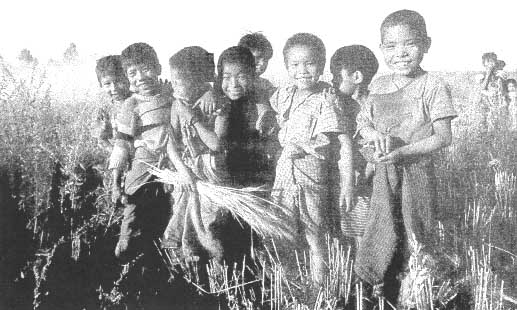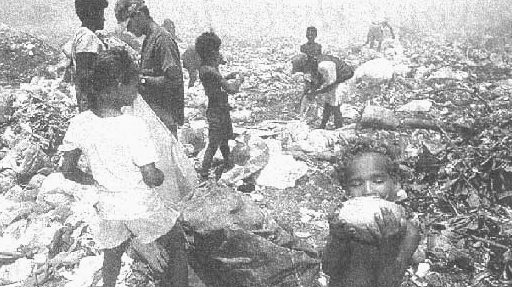The noted legal scholar Philip Alston has said that the right to food is the most urgently and frequently endorsed of any basic human right but is also the most systematically violated. Violation is almost entirely the result of the absence of enforcement mechanisms. The World Food Summit is an occasion for revisiting commitments already made and finding practical means to make them concrete and measurable.
THE UNIVERSAL DECLARATION of Human Rights, adopted by the UN General Assembly in 1948, included the statement that "everyone has a right to a standard of living adequate for the health and well-being of himself and his family, including food...". The right to food was further elaborated in the International Covenant on Economic, Social and Cultural Rights (1966) in the form of an assertion that "states Parties...recognize the fundamental right of everyone to be free from hunger...", and again in the International Convenant on Civil and Political Rights (1966).
Various UN documents and declarations have reasserted the right to food, including the 1974 World Food Conference Declaration and the 1992 Declaration of the International Conference on Nutrition. The World Food Programme and the World Food Council have both articulated this right as a fundamental human right and a central precondition for development.
The Convention on the Rights of the Child (1990) recognizes the child's right to the highest standard of health (Article 24) and the obligation of signatory governments to "take appropriate measures to combat disease and malnutrition..., through inter alia...the provision of adequately nutritious foods" (Article 24). Article 27 also specifies good nutrition as part of the adequate standard of living to which children have a right.
"Everyone has a right to a standard of living adequate for the health and well-being of himself and his family, including food..."
Universal Declaration of Human Rights, 1948
"States Parties...recognize the fundamental right of everyone to be free from hunger..."
International Covenant on Economic, Social and Cultural Rights, 1966
"Every man, woman and child has the inalienable right to be free from hunger and malnutrition."
World Food Conference, 1974
"The hungry cannot wait."
World Food Security Compact, 1985
"We pledge to act in solidarity to ensure that freedom from hunger becomes a reality."
International Conference on Nutrition, 1992

WHILE IS ALWAYS USEFUL to rearticulate rights, what is needed now is not another instrument by which governments state their commitment to the right to food but rather an instrument that outlines the practical means towards its implementation.
What steps need to be taken to ensure the satisfaction of the right of each person to food?
There is obviously no single, simple answer to this question. One consortium of US and Canadian NGOs, the Right to Food Working Group, has endorsed the proposal for an "International Food Security Covenant" that would require states to ensure access of all people to food associated with a specified minimal dietary standard, on which states would have to agree. Some NGOs and scholars have said that a world food reserve whose storage and distribution are overseen by a neutral agency is a key to ensuring food security. The elaboration of protocols for the establishment and maintenance of such a facility, to say nothing of a funding strategy, would require a concerted effort of UN agencies and member states. A mechanism for implementing the right to food would also have to include a system of recourse for persons or groups claiming that their right to food is being denied.
In UNICEF's view, the important point at this stage is the establishment of a clearly defined process that will result in an outline of a convention governing the implementation of the right to food. This process, which may be spearheaded by FAO and WFP, should include all UN agencies working on food security as well as other concerned intergovernmental bodies, key member states and key NGOs. It should build on the extensive discussions that have already taken place among NGOs, intergovernmental bodies and academic experts. It should have a fixed deadline for producing a draft convention, and the convention should specify further processes for monitoring progress and follow-up.
Without safeguards to protect disadvantaged children many are reduced to scavenging to survive

A recent example of an effort to give teeth to a human rights instrument is that of the Convention on the Right of the Child (CRC). The CRC has been the most rapidly ratified human rights instrument in the history of the United Nations, now ratified by all but six states only six years after the General Assembly approved it. UNICEF was instrumental in advocating for the ratification of CRC in many countries through its country offices and other means.
The CRC itself specifies rules for the election of members of a Committee on the Rights of thr Child, a committee of 10 international experts on child rights that has been working since February 1991. In ratifying the CRC, countries make a commitment to report to the CRC two years after ratification and every five years thereafter on their progress toward fulfilling the rights stated in the CRC. Governments are required to make their reports
"widely available to the general public" The Committee may respond to the reports in a variety of ways, including by proposing studies on particular issues in a given country or otherwise commenting on optimal implementation of the CRC.
Although this kind of mechanism is one whose effectiveness is based largely on exposing poor progress and exercising moral suasion, it is nonetheless powerful. The exposure of positive experiences and poor experiences to the scrutiny of world bodies and of the general public can only serve to keep children's rights higher on the global agenda and enable stronger and better targeted advocacy. The right to food deserves no less an effort.

This fact sheet was contributed by UNICEF.
For further information, please contact:
UNICEF One UN Plaza, New York, NY 10017, U.S.A
Tel: (001) 212 326-7000; Fax: (001) 212 503-0374
Internet, http://www.unicef.org
1. Jonsson, U. Nutrition and the United Nations Convention on the Rights of the Child. UNICEF/lnnocenti Occasional Papers, Child Rights Series no. 5. 1993.
2. Alston, P. and K. Tomaseveski, eds. The right to food. Dordrecht: Netherlands Institute for Human Rights, 1984.
3. International Food Security Treaty Campaign. International Food Security Covenant, draft 7.5. 1996